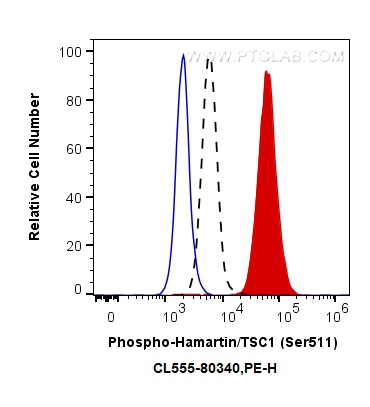验证数据展示
经过测试的应用
| Positive FC (Intra) detected in | Calyculin A treated HeLa cells |
推荐稀释比
| 应用 | 推荐稀释比 |
|---|---|
| Flow Cytometry (FC) (INTRA) | FC (INTRA) : 0.50 ug per 10^6 cells in a 100 µl suspension |
| It is recommended that this reagent should be titrated in each testing system to obtain optimal results. | |
| Sample-dependent, Check data in validation data gallery. | |
产品信息
CL555-80340 targets Phospho-Hamartin/TSC1 (Ser511) in FC (Intra) applications and shows reactivity with human, mouse samples.
| 经测试应用 | FC (Intra) Application Description |
| 经测试反应性 | human, mouse |
| 免疫原 |
Peptide 种属同源性预测 |
| 宿主/亚型 | Rabbit / IgG |
| 抗体类别 | Recombinant |
| 产品类型 | Antibody |
| 全称 | tuberous sclerosis 1 |
| 别名 | TSC1, TSC 1, TSC, LAM, KIAA0243 |
| 计算分子量 | 130 kDa |
| 观测分子量 | 150 kDa |
| GenBank蛋白编号 | NM_000368 |
| 基因名称 | Hamartin/TSC1 |
| Gene ID (NCBI) | 7248 |
| RRID | AB_2934694 |
| 偶联类型 | CoraLite®555 Fluorescent Dye |
| 最大激发/发射波长 | 557 nm / 570 nm |
| 形式 | Liquid |
| 纯化方式 | Protein A purification |
| UNIPROT ID | Q92574 |
| 储存缓冲液 | PBS with 50% glycerol, 0.05% Proclin300, 0.5% BSA, pH 7.3. |
| 储存条件 | Store at -20°C. Avoid exposure to light. Stable for one year after shipment. Aliquoting is unnecessary for -20oC storage. |
背景介绍
TSC1, also named as Hamartin, is a tumor suppressor gene syndrome whose manifestations can include seizures, mental retardation, autism, and tumors in the brain, retina, kidney, heart, and skin. The tuberous sclerosis 1 (TSC1)/TSC2 tumor suppressor complex serves as a repressor of the mTOR pathway, and disruption of TSC1/TSC2 complex function may contribute to tumorigenesis. TSC1 is phosphorylated by IKKb at Ser487 and Ser511 in vitro and in vivo, and phosphorylation at these sites enhances dissociation of the TSC1/TSC2 complex, which in turn induces mTOR activation. (PMID: 17693255). TSC1 is also threonine-phosphorylated at three sites (Thr417, Ser584, and Thr1047) in a reaction catalyzed by cyclin-dependent kinase 1 (CDK1) (PMID: 14551205).


